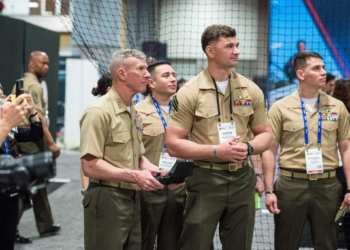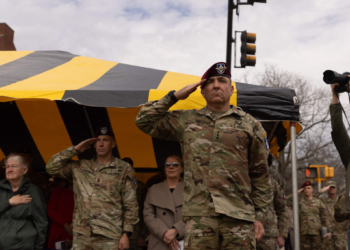Imagine if a robot could go ahead of troops, by a kilometer or more, to assess a situation and relay information back that would help commanders know what’s ahead and know how to respond?
Army Futures Command isn’t just imagining that- they’re already building it.
“This isn’t about robots or technology, this is about soldiers and this is about commanders on the battlefield, and giving them the decision space and reducing the risk of our men and women when we go into the nastiest places on the planet,” Brig. Gen. Ross Coffman, director of the Army’s Next Generation Combat Vehicle-Cross Functional Team, told reporters during a virtual discussion about the Robotic Combat Vehicle Soldier Operational Experiment.
A platoon of soldiers from the 4th Infantry Division at Ft. Carson, CO spent much of this summer sending two-person crews out in modified Bradley fighting vehicles to control robotic surrogate vehicles that were built from M113 armored personnel vehicles. The goal of the experiment was to observe the vehicles and to collect and analyze feedback from the soldiers working with them on the feasibility of integrating robots into ground combat formations.
The modified Bradleys are known as Mission Enabling Technologies Demonstrators (MET-Ds) and the modified M113s are known as Robotic Combat Vehicles (RCVs).
The goal of the program is to eventually build a collection of vehicles that can be used to provide reconnaissance capabilities and standoff distance or to replace soldiers in high-risk activities like combined arms breaches and chemical, biological, radiological, nuclear and explosives (CBRNE) reconnaissance.

“The human is in charge,” Coffman said. “But we’re looking for a level of autonomy that allows the machine to do mundane things, to take that off the human.”
Coffman emphasized that this summer’s experiment at Ft. Carson was just that, an experiment, and not a test and that there is still much work to be done before soldiers will be able to use robots downrange.
“Right now, it’s difficult for a robot, when it looks at a puddle, to know if it’s the Mariana Trench or two inches deep,” said Maj. Corey Wallace, RCV lead for the Next Generation Vehicle-Cross Functional Team. “The RCV must be able to sense as well as a human. It needs to hear branches breaking around it. It needs to know when it’s on soft sand or an incline. We still need to work on that.”
Jeffrey Langhout, director of the Army’s Combat Capabilities Development Command’s Ground Vehicle Systems Center, acknowledged that the robots still have a ways to go and noted that there are particular challenges involved in designing a robot vehicle for combat.
“Right now, we don’t have the sensors to tell us if a puddle is something we can drive through. In the auto industry, high-tech cars are operating on pavement and in a generous GPS environment. We are looking at how to operate in a denied environment, where things can go bad quickly,” Langhout said.
Earlier this year, the Army selected two companies, QinetiQ North America and Textron, to build the eventual vehicles. QinetiQ North America will build four prototypes of the Robotic Combat Vehicle-Light and Textron will build four prototypes of the RCV-Medium. Coffman said that the Marine Corps is also using QinetiQ to build an RCV-Light and the two services and working together on the designs.
All in all, Coffman said the experiment was “100% successful.”

“We learned where the technology is now and how we can fight with it in the future,” Coffman said.
And just how far in the future are we talking? Unfortunately, pretty far.
Coffman said a second experiment is planned for Ft. Hood, Texas in the first part of the fiscal year 2022 using the same M113 robot vehicles and Bradley control vehicles in company-size operations. After that, an experiment will be held to test the vehicles in more complex situations. And after that, the Army will decide if robot vehicles are worth further investment.
This is to say that, cool as the robots are, for now, most soldiers and military families will have to be content just imagining them.
Read comments





































